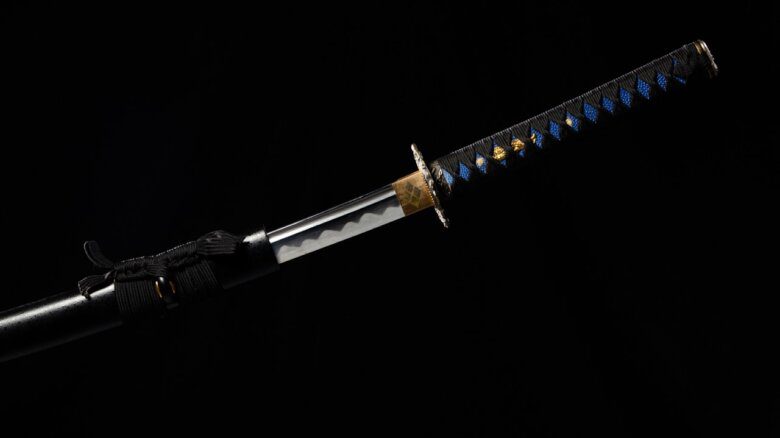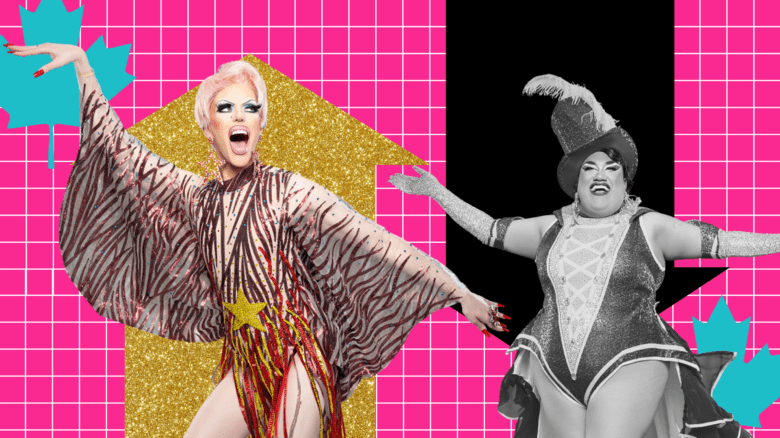My first cosplay wasn’t one I would have chosen for myself. Like many things I tried in my teens, I got into it because my friend was doing it.
It was 2010 and Susie was attending her first fan convention in London, U.K. She wanted to dress up as characters from the short-lived webcomic Hanna is Not a Boy’s Name. That’s the heart of cosplaying: the act of dressing up as beloved characters—often from television shows, comic books or games—typically for fan conventions. Susie was cosplaying Conrad Achenleck, a prissy vampire mocked for his snaggletooth and love of argyle. My hair was short and blond like Doc Worth’s, so she roped me into dressing as him—a back-alley medical professional with an Australian accent and a cigarette perpetually hanging from his mouth.
To become Worth, I sewed faux fur onto a lab coat I stole from my brother and painted stubble onto my face with shimmery brown eyeshadow. I’d been to conventions before, but I had never cosplayed. Our costumes were incredibly specific, and yet we met some strangers who were cosplaying characters from the same webcomic. Suddenly, I had a new group of friends.
For the next year of my life, my cycle of school and depression and gigs was punctuated by semi-regular cosplay meet-ups at conventions across the U.K. And though Worth was skeezy and a total jerk—like if Benedict Cumberbatch’s Sherlock or Robert Downey Jr.’s Tony Stark had none of the genius to back up their bad attitudes—I kept dressing up as him. He wasn’t a character I would have chosen to step into, but I loved him nonetheless.
I loved making strangers happy when they recognized my niche cosplay choice. I loved my ragtag cosplay group that incestuously dated each other before drifting apart (it was, after all, where I met my first two girlfriends). But most of all, I loved that my cosplay replaced my body as the primary signifier of my gender; that, at a convention, my physical form mattered less than the physicality of my character.
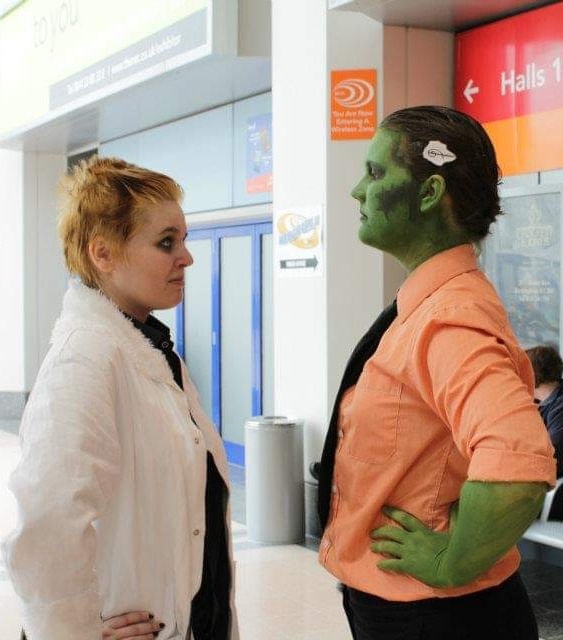
The author, left, and their friend, Susie, in cosplay from the webcomic 'Hanna is Not a Boy's Name.' Credit: Courtesy V.S Wells; photo by Ruben Willis-Powell
Cosplaying as a character whose gender is different from your own is often known as “crossplaying”—a term I’m not fond of, due to its associations with cross-dressing and the assumed cis-ness of all involved. But discussions of identity and gender in this context matter. The 2018 erotic comic book Crossplay by Niki Smith complicates this simple idea: Characters engage in gender-bending cosplay to explore their own identities.
In the book, Alexis and Sierra are girls who cosplay as boys because it makes them happy. J is in awe of them, until a non-binary character helps him understand his own identity as a trans man. And there’s an unnamed assigned-male character wearing a princess dress, which their partner has lovingly sewn. By including trans and non-binary characters, Smith represents a surprisingly common experience: that of gender-questioning people using cosplay to feel out their identity.
That’s the beauty of cosplay; unlike drag, which implies having stage and performance chops, it’s low-stakes. Performing for judgment is optional. Instead, you exist in a sea of other folks. People don’t question your gender if you’re dressed as a character of another gender. Fellow convention-goers don’t make snap judgments about your sexuality or identity the same way the general public might. The collective agreement—that people dressed up as characters are indulging in something playful and make-believe—means that it can be easier for gender nonconforming and trans people to try on things that they’ve always wanted to wear. You can defend it as being “just for fun,” even if it sparks something much more serious in your heart. And for many, it’s a safe way to play with gender for the first time.
The term “cosplay”—a portmanteau of “costume” and “play”—was coined by Nobuyuki Takahashi in a 1983 magazine article, after he witnessed droves of fans at conventions masquerading as their favourite fictional characters. The practice has long had roots in pop culture dress-up, all the way back to the 1930s. But nowadays, it has evolved into a subculture rooted in queerness and gender-bending. A 2013 paper by Jason Bainbridge and Craig Norris has gone as far as to call cosplay “post-human drag.” By cosplaying, they argue, you create “sutures” between this real world and the fictional one of your character.
What the academics don’t realize is that cosplay can create sutures within a person, too—between the fiction of other people’s perceptions of you and the reality of who you truly are.
“The idea that crossplayers might actually be trans people exploring or affirming their gender isn’t really talked about—for the most part, trans and non-binary folks aren’t part of the conversation”
Kayla Hammond, a cosplayer from Washington, used to dress up as their favourite characters to help them figure out they were agender. “I went through a period where I only wanted to do female characters, to the point where even if I had a male character, I would sort of gender-bend them into a girl,” they tell me. “I thought I just didn’t look as good as a boy.”
As they thought more about their gender, they started moving toward cosplaying as more masculine characters. “I thought, okay, I’m going to crossplay and do boy characters because I like it.” This lasted “maybe two or three years before I actually started to question my actual gender identity,” they say. But as Hammond came to identify as agender—without, they say, “any strong emotional connection to any gender at all”—their cosplay shifted, too. These days, they cosplay as both masculine and feminine characters. “I’m just as comfortable trying on different aspects of femininity as I am of masculinity, and I tend to just fall somewhere in the middle,” they say.
Hammond spending years “crossplaying” before considering their gender identity shows how pervasive cisgender narratives are in cosplay spaces. The idea that crossplayers might actually be trans people exploring or affirming their gender isn’t really talked about—for the most part, trans and non-binary folks aren’t part of the conversation.
“Many discussions of cosplay and gender seem to elide discussions of queer, trans or non-binary cosplayers,” writes researcher and cosplayer Emerald L King in a 2015 article. “That’s born out both in academic studies of cosplay, and in cis-dominated cosplay spaces online.” A Grinnell College resource on queer theory echoes that sentiment: “Though people outside of anime fandoms and the cosplay community often stereotype crossplayers as closeted queer folks, the reality is that the majority of crossplayers are cisgender heterosexual individuals,” it reads. The insistence that most crossplayers are cisgender ends up straightwashing queer narratives out of sight. Another paper, “Gender, Sexuality and Cosplay: A Case Study of Male-to-Female Crossplay,” focuses entirely on straight men cosplaying as female characters. The only mention of transness is a throwaway comment explaining how these straight male crossplayers resent assumptions of transness.
And out of the dozens of papers I read on cosplay and gender, only one even considered the possibilities of trans people participating. It was a dissertation on gender-creative Harry Potter cosplay—written by Charles Ledbetter, a trans man. Through his research, Ledbetter found that “cosplay decentered gender as a primary category of identification.” As he explains over email, “Some people did use it [cosplay] as a playground for gender exploration, but in talking to cosplayers I realized that gender was secondary to inhabiting character.”
In some ways, the gender of my first cosplay was a non-factor. I was dressed in costume because it was something my friends liked doing. I thought it didn’t matter to me who I was, so long as it was fun. Cosplaying as characters I admired initially felt separate from exploring my gender identity.
I also spent much of my teens obsessing over fictional male characters, like Tamaki from the anime series Ouran High School Host Club and Howl from the Studio Ghibli film Howl’s Moving Castle—two peacocking blond boys whose maleness was never called into question, despite their vanity. They lived in a world of feminine masculinity that I wanted to stick a straw into and drink up. My cousin offered to help me with both their outfits, but we never had time to make it work. Those were my first twinges of genderqueerness, but it was easy to stamp them out: Tumblr was full of girls who cosplayed as boys, often those who they were attracted to. I assumed my love of Tamaki and Howl was heterosexual fangirling and nothing more, despite the fact I’d been identifying as bisexual since age 12.
The first time I cosplayed as Worth, I realized how much I liked embodying his uncomplicated masculinity. When I looked around at Susie and my new female friends who cosplayed as men, I wondered if they all felt like I did—like living in this imaginative place made them feel more real. Cosplay was the first space where I felt like being somewhere in between male and female was where I was most comfortable.
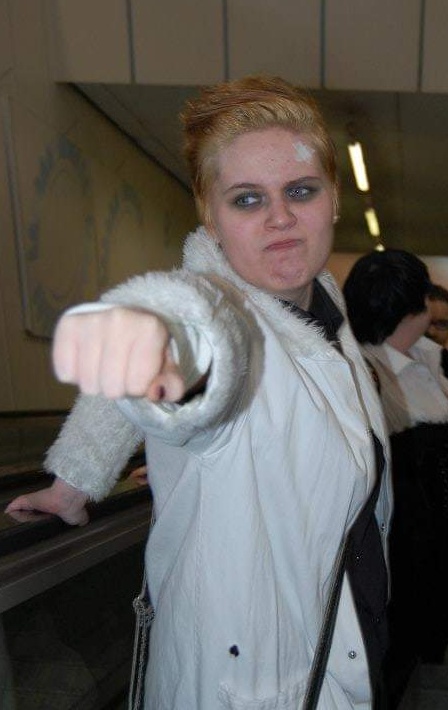
The author in cosplay. Credit: Courtesy V.S. Wells; photo by Ruben Willis-Powell
For my girlfriend Marcy, the world of cisgender crossplayers was especially confusing. She stumbled upon cosplay as a teenager on the online message board 4chan, several years before she started admitting her gender dysphoria. “I had a huge amount of respect and maybe even deification of people who did crossplay,” she tells me. “There were no male characters for whom I was like, ‘Wow, that’s so cool, I want to be them.’ But there were lots of female characters.”
Crossplay created a space where she felt like she could fit in: Her admiration for men who crossplayed as female characters made it feel like she could do that, too. Crossplaying as female characters was fine, the internet said, so long as you didn’t think you really are a woman. The first time she wore a skirt in public, she cosplayed as Ryko Matoi from the anime Kill la Kill. At the time, she identified as a cross-dresser—because that was the terminology her internet spaces used.
“Just because cosplaying is a comparatively safe space doesn’t mean it’s perfect—transphobia is still prevalent”
For Marcy, crossplaying in public also provided positive feedback from other people. “You’re actively celebrated for who you’re being and how you’re presenting yourself. I think it’s an incredibly affirming sort of space,” she tells me. “It definitely helped me reinforce those presentation ideas, like, ‘Yes, I’m not strange to want to present myself in a more feminine way.’”
But just because cosplaying is a comparatively safe space doesn’t mean it’s perfect. Transphobia is still prevalent—as affirming as it is to dress however you want, having strangers see through your cosplay can be hurtful. And due to the prevalence of cisgender people who cosplay, it’s not uncommon to refer to cosplayers as the perceived gender of the cosplayer instead of that of the character. Marcy remembers the first time she wore her Ryko cosplay at a fan convention in London. “Someone in one of the merch stands was giving cosplayers free little badges based on their costumes, and they gave me a ‘cross-dressing boy’ pin,” she recalls. “It made me feel kind of shitty. At the time, that’s what I thought I was, but it still made me feel shitty.”
Kyler Williams, a trans person from California, struggles to correct people at conventions who assume he’s female. “Me and the character I’m cosplaying as are two different entities,” he says. “But I normally don’t have the heart to correct people on my pronouns, because that involves having to come out and I hate doing that.”
And while he identifies as non-binary and sometimes cosplays as female characters, he’s not entirely comfortable with how onlookers assume gender based on his costume. “Part of me doesn’t mind [if] people think of me as a woman because my character is. But if they think me as a person is a woman, then it just makes me feel shitty.”
For many, the potential drawbacks of cosplaying are outweighed by the positive experiences they have in costume. Maxel Riverin, a trans man from Quebec, first started cosplaying in 2014 while he identified as genderfluid. His first cosplay was Kuroko, the eponymous basketball prodigy from the manga series Kuroko no Basuke.
“It was liberating! It felt like I was able to look like what I imagined in my head,” he says. “I guess I fell in love with the idea of becoming the characters I relate to for a while.”
Riverin has long been a fan of sports anime, a genre that revolves around (typically) male characters excited to play various high-school sports. Often, athletics takes a backseat to the relationships that happen between characters on the team. “All the fandoms I’ve been in are welcoming,” Maxel says. “There’s no toxicity.”
Kayla Hammond, the cosplayer from Washington, felt that cosplaying at conventions was a safe space to try out different gender presentations. “It’s comfortable to be able to express myself as male, especially in the context of cosplay,” they say. “If you’re not totally out to other people or out to yourself yet, it’s safer to be like, ‘I’m going to dress as a boy because it’s cosplay, it’s just for fun.’ I’m not going to have to have anybody necessarily question what my gender actually is.”
“Being in the cosplay made me feel really masculine, and any doubts I had about myself was thrown out the window”
While assigned-female people have a certain amount of social leeway for dressing more masculine, the same isn’t true for assigned-male people. My girlfriend found that cosplaying was like a baptism of fire. “I know, for a lot of people, there’s a lot of initial fears about going out presenting as your gender for your first time,” she says. “I feel like cosplay softened a lot of that for me because I’d already gone so extreme.” Her outfit for anime character Ryko involved “a tiny skirt and crop top showing your entire tummy.” By contrast, going out during the day in feminine clothing was less scary.
Williams found that cosplay was what helped him tap into his masculine side. Cosplaying as Noctis from the game Final Fantasy XV made him feel more confident. “Being in the cosplay made me feel really masculine, and any doubts I had about myself was thrown out the window, because I really enjoyed dressing up as him,” he says. “Noctis […] makes me ooze masculinity.”
I didn’t come out as non-binary until I was 20, long after my teenage cosplaying days were behind me. I never wore a binder, because the physical discomfort of binding H-cup breasts outweighed my social discomfort of looking too female.
The last time I cosplayed was in 2017, shortly before moving to Canada. Marcy dusted off her Ryko cosplay, and I roped one of our housemates into helping me make an outfit for Ryko’s ditzy love interest, Mako Mankanshoku. I’d cosplayed girls before, when I still identified as female. Cosplaying as Mako once I identified as non-binary was freeing. She was just another costume to slip into.
Now that conventions are cancelled for the foreseeable future, I’ve started wondering about cosplaying again. If there are no social gatherings for the next year, that might be enough time to learn how to sew—or find a blue jacket I can repurpose into Tamaki’s blazer.
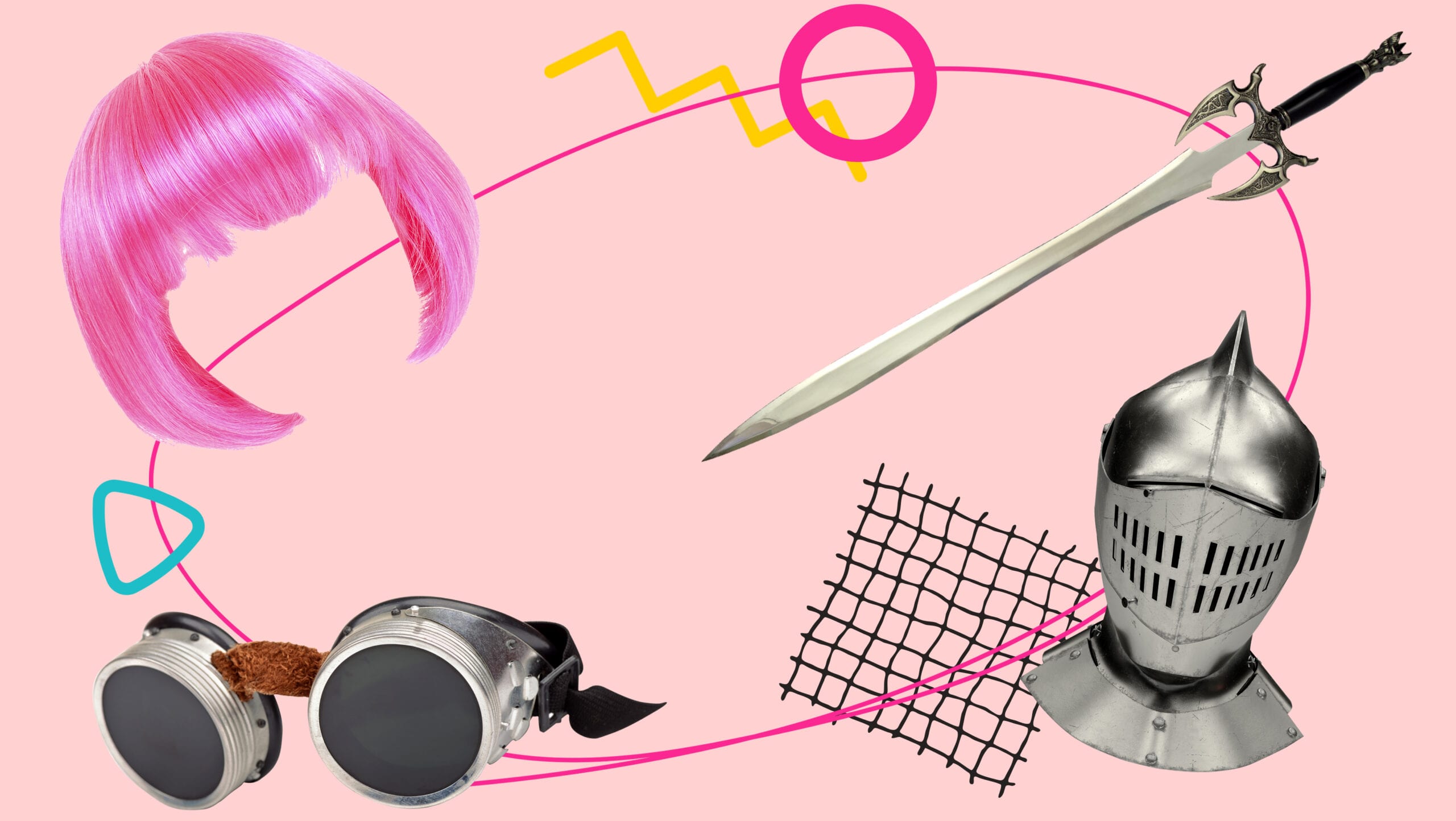

 Why you can trust Xtra
Why you can trust Xtra

